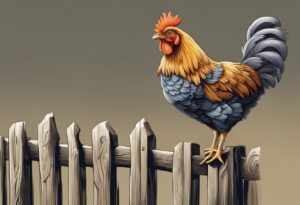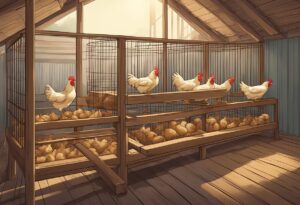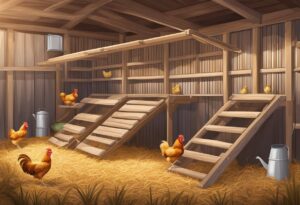A chicken perch is essential in any coop, providing a safe and comfortable space for chickens to rest. Chickens need perches to avoid predators and maintain their health and well-being. Properly designed perches can help keep chickens warm, offer a view of their surroundings, and prevent foot injuries.

When creating a chicken perch, it is essential to consider the size, material, and height. Many coop owners choose natural branches, wooden bars, or repurposed materials to build adequate perches. Additionally, regular maintenance ensures they remain safe and functional for the flock.
Providing chickens with the right perch can significantly enhance their living conditions. A well-thought-out perch creates an ideal roosting environment, contributing to happier and healthier chickens.
Key Takeaways
- Chicken perches are vital for safety and well-being.
- Proper design and installation enhance the roosting experience.
- Regular maintenance of perches is necessary for chicken health.
The Importance of Chicken Perches

Chicken perches play a vital role in hens’ well-being and behaviour. Properly designed perches can enhance health and promote natural behaviours, making them essential features in any coop.
Health Benefits for Chickens
Perches provide a safe place for chickens to sleep off the ground. This keeps them away from dirt and parasites, reducing disease risk. Chickens naturally prefer to roost at higher elevations.
Key considerations for perches:
- Material: Using sturdy materials, like wood, is crucial. Rounded edges are recommended to prevent foot injuries.
- Height: Perches should be about 18 to 24 inches from the floor for easy access. Higher perches can be provided if chickens can reach them safely.
Healthy perching habits can lead to fewer health issues, ensuring hens stay active and productive.
Behavioural Advantages
Chickens exhibit social behaviour through roosting. Perches help establish a flock’s pecking order, with dominant hens often occupying higher spots. This natural hierarchy reduces stress among birds.
Additional behaviours promoted by perches:
- Comfort: They give chickens a sense of security while sleeping. This helps them feel safe from potential predators.
- Spacing: Proper spacing on perches is essential. It allows chickens to find their preferred spot without overcrowding.
Incorporating perches into a chicken coop meets health and behavioural needs, leading to happier and more social flocks.
Designing Chicken Perches

Designing adequate chicken perches is essential for hens’ comfort and well-being. Proper materials, height, and spacing contribute significantly to their roosting habits and overall health.
Material Selection
It is crucial to choose the right materials for chicken perches. Popular options include wooden boards, PVC pipes, and metal rods.
- Wood is preferred because it provides a natural grip. Use untreated wood to avoid chemical exposure.
- 2×4 lumber is commonly used, placed flat for roosting comfort. It offers enough space for the birds’ feet.
- PVC pipes are lightweight and easy to clean but may not provide the best grip.
- Metal rods can be slippery, making them less suitable for all chickens.
Selecting sturdy, smooth materials ensures the birds’ safety and comfort while roosting.
Determining the Proper Height
The height of perches should consider the breed and age of the chickens. Generally, the perches should be elevated but accessible.
- For standard breeds, a height of 4-6 feet is often appropriate.
- Bantams may require lower perches, around 2-3 feet high.
It is essential to ensure that young or smaller chickens can easily reach the perches. Additionally, placing the perches higher helps prevent ground-dwelling pests from reaching the hens.
Spacing Requirements
Space is a significant factor in perch design. Each chicken needs enough room to roost comfortably without crowding.
- Aim for 8-12 inches of horizontal space per hen.
- Allow for enough distance between multiple perches to avoid direct droppings.
If using multiple roosts, a spacing of 12-18 inches vertically is advisable. This keeps hens from bumping into each other, maintaining a peaceful environment. Proper spacing also allows air circulation, which is vital for keeping the coop fresh and reducing odours.
Installation of Chicken Perches
Proper installation of chicken perches is essential for the comfort and safety of the flock. It involves careful planning to ensure perches are secure, accessible and well-suited for the chickens. The following sections provide key information on safety measures, stability, support, and accessibility.
Safety Measures
Safety is a priority when installing chicken perches. First, the materials should be free from toxic chemicals or paints. Natural wood perches are often favoured but should be inspected for splinters or rough edges.
Regular checks are necessary to ensure perches remain in good condition. Any signs of wear or instability should prompt immediate replacement. Annual replacement is recommended for using untreated wooden branches to prevent pest infestations.
It is also essential to avoid sharp angles or protrusions that could injure the birds. Ensuring rounded edges and smooth surfaces can significantly enhance safety for the flock.
Stability and Support
Stability is crucial for the effectiveness of chicken perches. The perches should be securely attached to prevent swaying or tipping. Using sturdy brackets or screws will enhance support.
The size of the perch matters, too. Ideally, perches should be at least 2 inches wide to provide a comfortable grip for chickens. Placement height is typically between 2 to 4 feet from the ground, allowing for easy access without causing injury.
Adding support legs can further enhance stability, especially for freestanding perches. Stability reduces the chances of accidents as chickens jump on and off.
Accessibility for Chickens
Accessibility is vital for ensuring all chickens can comfortably use the perches. Perches should be located at various heights for easy access. This setup mimics natural behaviours and allows weaker or younger birds to find their place.
Installing perches like stairs can help chickens climb safely. A good rule of thumb is to space perches at least a foot apart. This respects their need for personal space while preventing overcrowding.
If higher perches are used, consider adding ramps or barriers for security. Proper accessibility encourages healthy roosting habits and motivates the flock to use the perches regularly.
Maintenance of Chicken Perches
Maintaining chicken perches is essential for ensuring the health and comfort of a flock. Regular cleaning and inspections can help prevent health issues and extend the life of the perches.
Cleaning Protocols
Cleaning chicken perches should be done regularly to keep the environment hygienic. It is best to scrape off droppings at least once a week. Using a putty knife or a similar tool makes it easy to remove waste quickly.
Removing the perches for a thorough cleaning is beneficial on warmer, sunny days. Scrub them down with a solution of water and vinegar or a chicken-safe cleaner. Ensure that they dry completely before putting them back. This prevents moisture accumulation, which can lead to mould.
After cleaning, the perch’s surface should be checked. Look for rough spots or sharp edges that could harm the chickens’ feet. A smooth surface is ideal for a comfortable roosting experience.
Regular Inspection for Wear and Tear
Regular inspection of chicken perches helps identify signs of wear and tear. Perches should also be checked for stability, especially at the joints. They need to be secured or replaced if they are loose or wobbly.
Look for signs of splintering or cracking in the wood. These issues can cause injury to chickens. It’s also important to measure the diameter of the perch. A diameter of around 2 inches is generally comfortable for chickens.
Another key point is ensuring that the perches are at the correct height. The lower perch should typically be about 18 inches off the ground, and the highest perch should not exceed 4 feet. This height keeps chickens safe and comfortable while roosting.
Types of Chicken Perches
Choosing the correct type of perch is vital for a chicken’s well-being. Different perches meet various needs and preferences, which can affect comfort and health. Below are some popular options available for chicken owners.
Natural Branch Perches
Natural branch perches are often favoured for their organic feel. They can be made from tree branches that offer an uneven surface, mimicking a chicken’s natural environment and providing better foot health.
When selecting branches, it’s essential to ensure they are safe and untreated. Popular options include oak and pine. They should be sturdy enough to hold the weight of the chickens.
Advantages of Natural Branch Perches:
- Provide variety in diameter for foot exercise.
- Help promote healthy feet.
- Blend well in a natural-looking coop.
Shedding bark or rough surfaces on some branches can help chickens grip better.
Manufactured Options
Manufactured perches are available in various materials, such as wood, PVC, or metal. These options often have consistent dimensions, making installation easier. Many manufactured perches are designed to prevent splinters and are easy to clean.
Some models are adjustable, allowing for customisation of height and spacing. This is especially useful for mixed flocks of different sizes. Chicken owners can find various colours and designs to match their coop’s aesthetic. Use this link to view different designs at Amazon
Features of Manufactured Options:
- Uniform size and easy to install.
- Often treated to prevent rot or pests.
- May come with built-in features like hooks for hanging.
These perches can be a long-term investment in the chicken’s living space.
Adjustable Perches
Adjustable perches offer flexibility for different chicken needs and preferences. They can be altered in height and orientation, which is especially beneficial for older or special-needs chickens.
They can be made from various materials, including wood and metal. Adjustable options can grow with the flock, accommodating larger or heavier birds over time.
Key Benefits of Adjustable Perches:
- Can be tailored for individual flock needs.
- Facilitate easier cleaning and maintenance.
- Allow for optimisation of coop space.
This adaptability makes them a practical choice for any chicken owner looking to provide the best environment.
Enhancing the Roosting Experience
Improving chickens’ roosting experience involves careful attention to their comfort and safety. Proper padding and thoughtful placement are crucial elements that can significantly improve hens’ nighttime rest.
Padding and Gripping Surfaces
Adding padding or using suitable grip materials can significantly enhance a chicken’s roosting experience. A broad, rounded wood roost is comfortable for chickens’ feet.
Soft materials like straw or hay beneath the roost can add comfort and warmth. Many chicken owners wrap perches with non-slip material or rope, which can prevent slipping and enhance safety.
Roosts should be at least 2 inches wide to support the chickens’ feet. Regular checks ensure the surfaces remain clean and in good condition, minimising discomfort and health issues.
Placement within the Coop
The placement of the roosting area in the coop plays a vital role in how comfortable chickens feel. Roosts should be set 2 to 4 feet off the ground. This height keeps chickens safe from ground predators and fulfils their instinct to perch up high.
It’s best to keep roosts away from drafts and damp areas. A well-ventilated space helps maintain air quality while avoiding excess moisture that can lead to health problems.
Creating adequate space between roosts is also essential. This allows chickens to move without crowding, reducing stress and promoting a peaceful environment during sleep.
Frequently Asked Questions
This section addresses common questions about chicken perches. Understanding chicken perches helps in creating a safe and comfortable environment for poultry.
What are some creative ideas for building a chicken perch?
Some creative ideas include using natural branches, reclaimed wood, or PVC pipes. Various heights can encourage chickens to explore, and adding multiple perches can also enhance their play area.
How can I DIY a chicken perch for my coop?
To make a chicken perch yourself, start by selecting sturdy materials like wood or metal. Cut the material to the desired length and secure it to the coop walls. Make sure it is at a comfortable height for the chickens to access.
What factors should I consider when choosing the size of a chicken perch?
When choosing perch size, consider the number of chickens and their sizes. A good rule of thumb is to provide 8-12 inches of space per bird. The width should be comfortable, typically 2 to 4 inches.
What are the benefits of having a chicken perch ladder?
A chicken perch ladder offers several benefits. It provides climbing exercise, improves social interactions, and helps chickens maintain their natural behaviours. It can also save space in the coop.
How many roosting bars are necessary for a flock of 12 chickens?
At least two roosting bars are recommended for a flock of 12 chickens. Each bar should offer enough space for all birds to roost comfortably. This setup reduces stress and promotes harmony among the flock.
Do chickens prefer round or flat roosting bars?
Chickens generally prefer flat roosting bars. Flat surfaces allow for more comfortable footing, especially for larger breeds. However, some breeds may enjoy round bars as they mimic natural perches.
